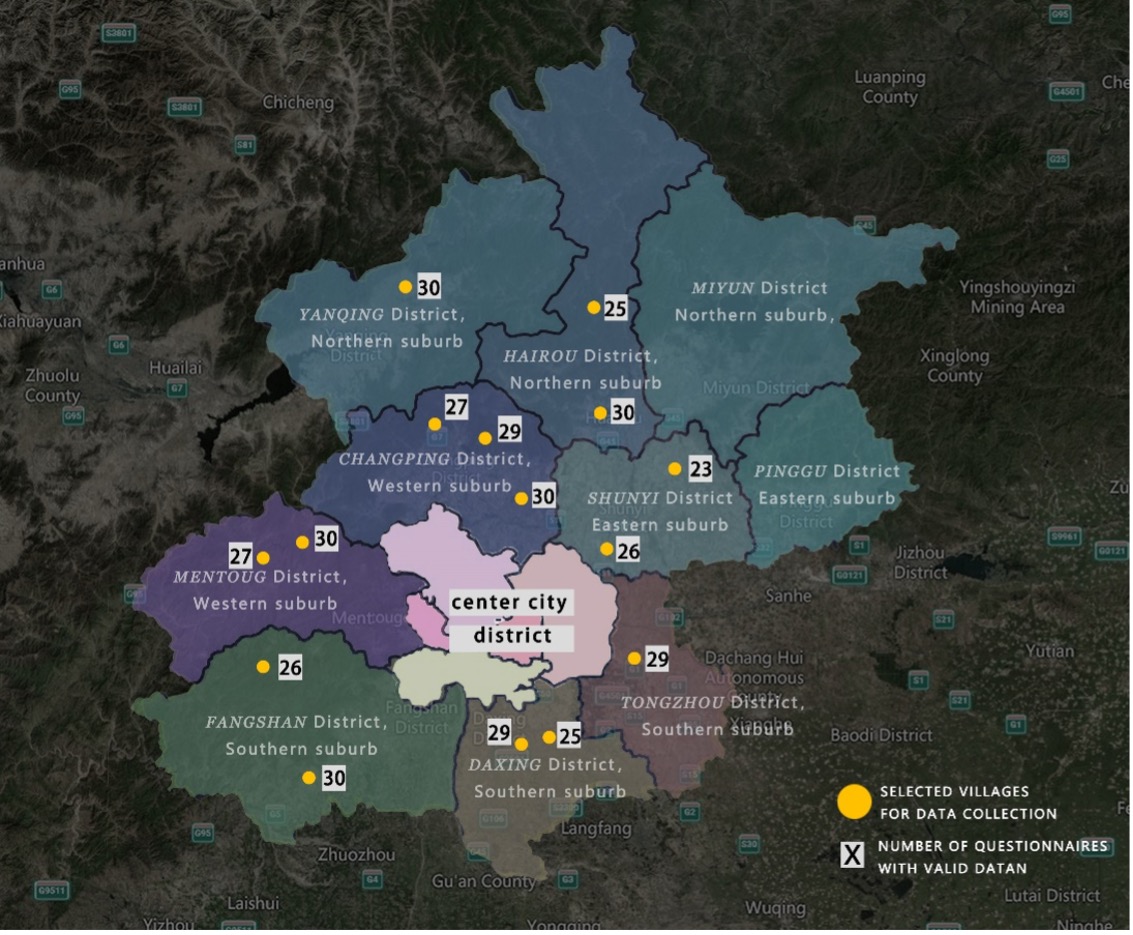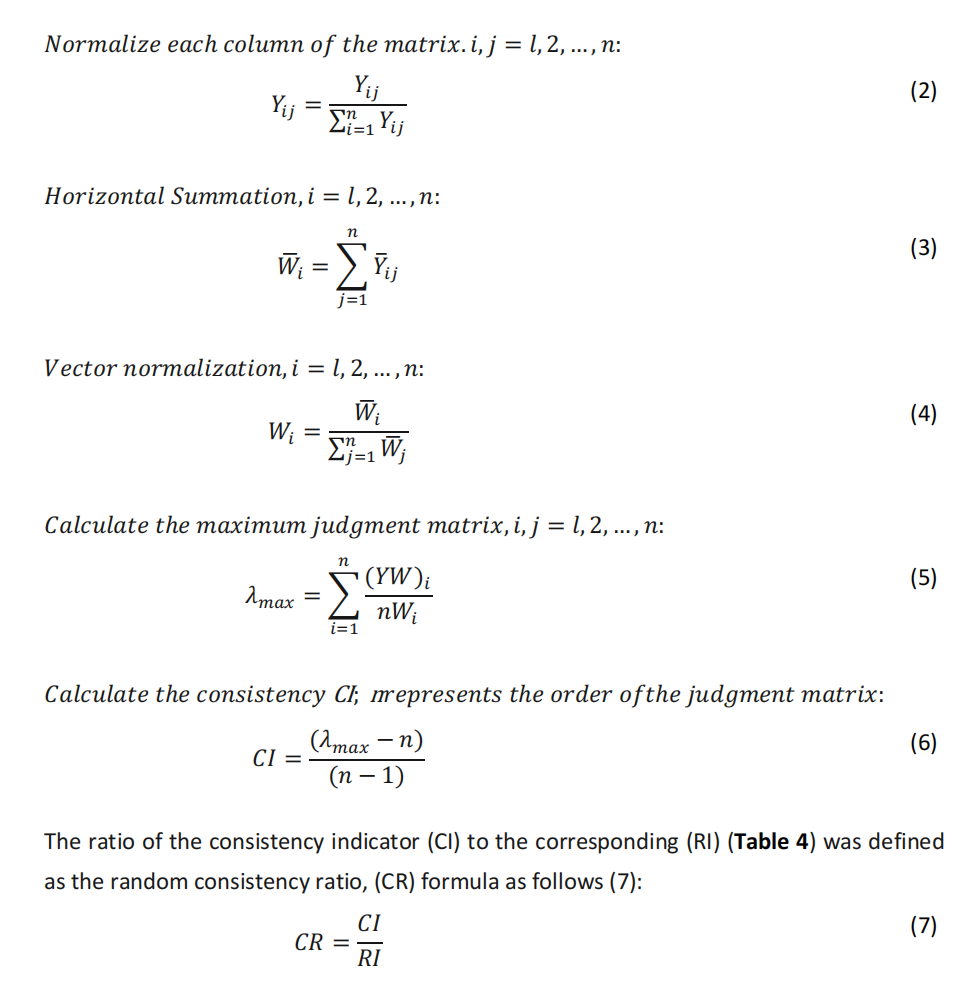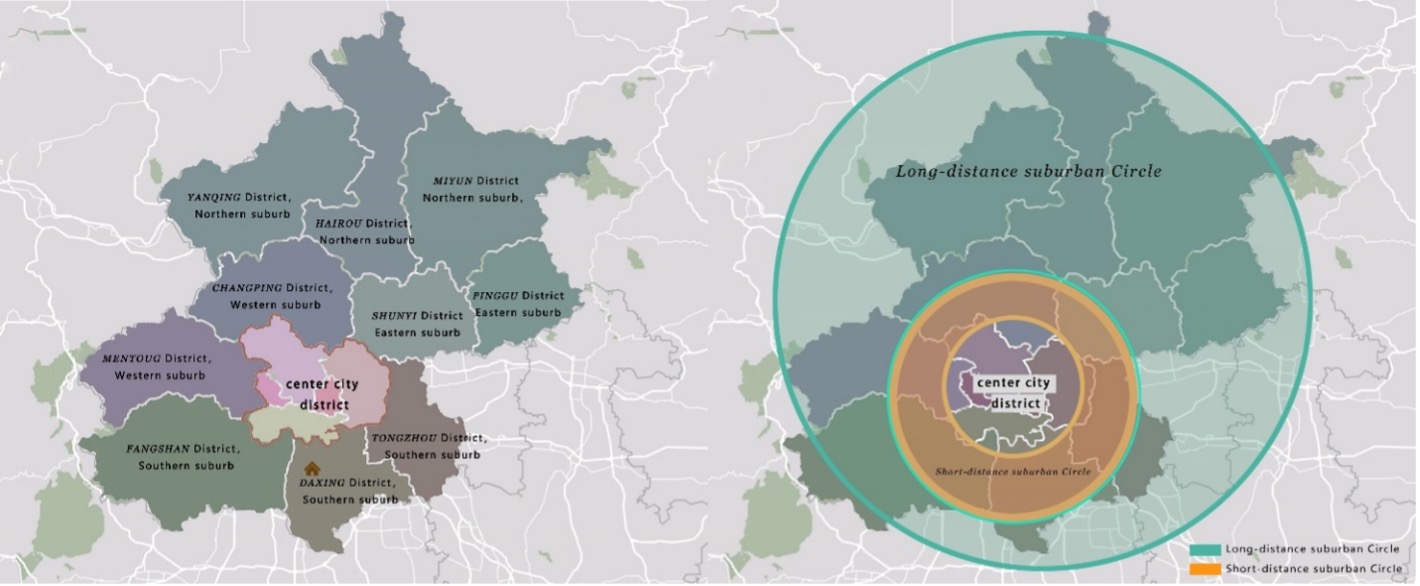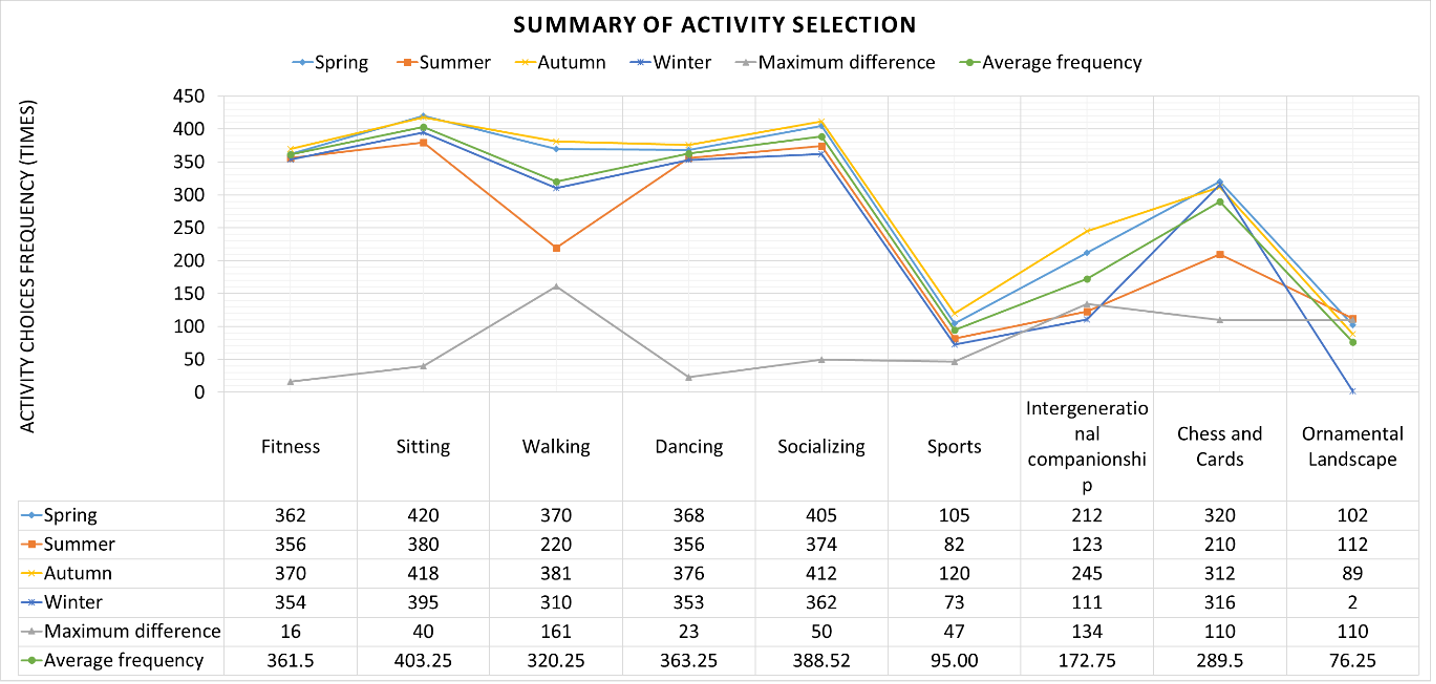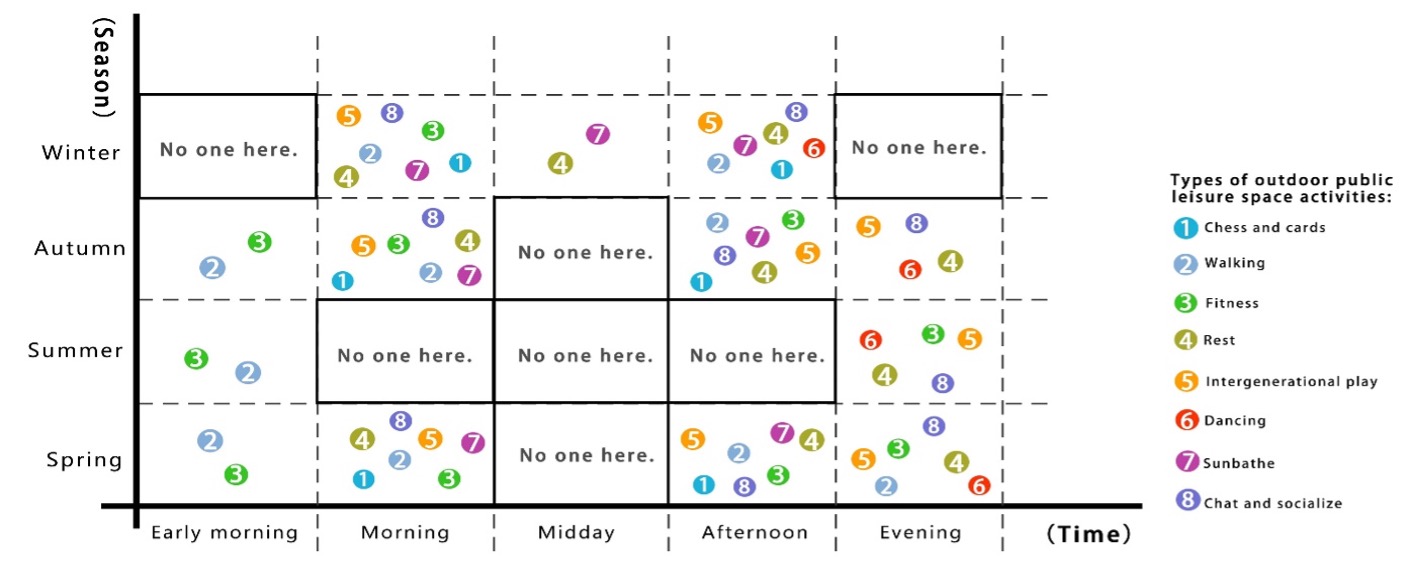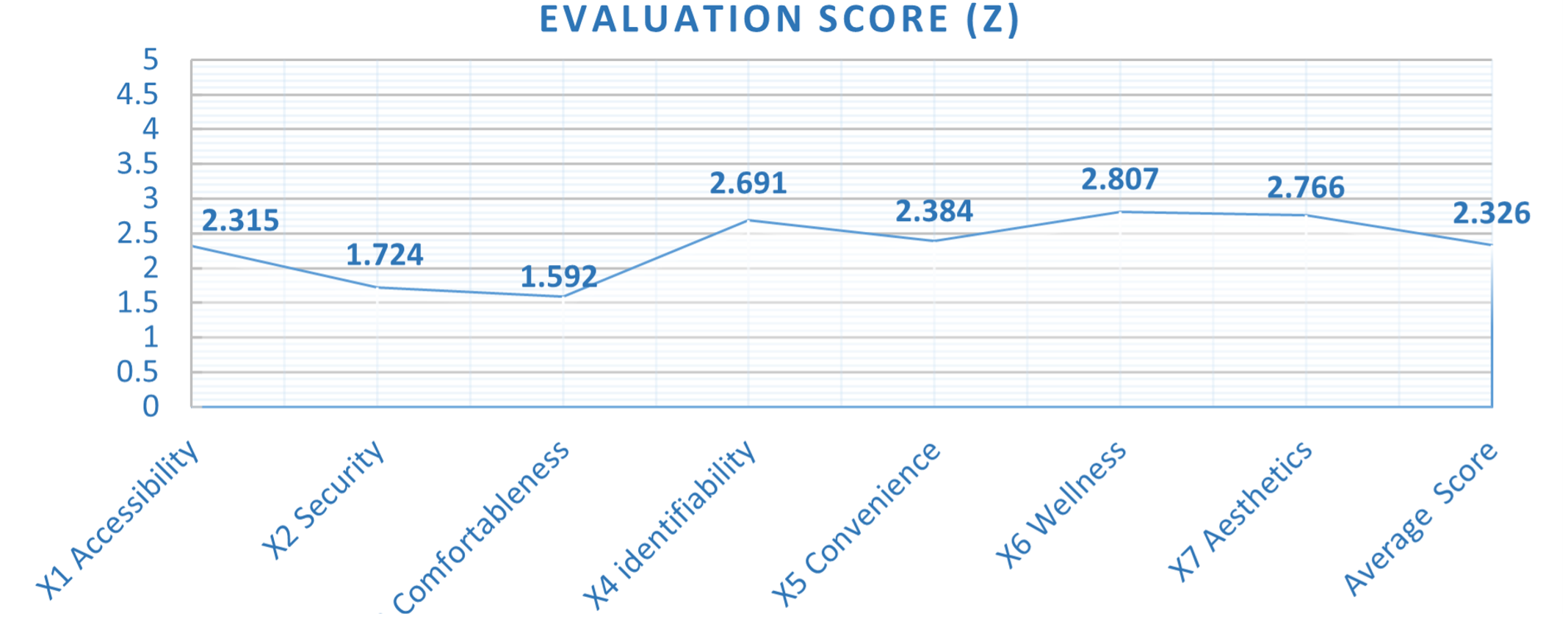As shown in the table above, The top five of S ̅ are Y16 \ Y 3\ Y 18 \ Y 20 \ Y 17, The bottom five are Y11 \ Y 7\ Y8 \ Y21 \ Y 5 ; Y16 is the top position in terms of S ̅(2.905), while Y5 ranks last (1.88).
Results of Quantitative Analysis
Weight Values of Evaluation Indicator
(1) Results of Preliminary Calculation
Building upon the preceding 3.3.2 Calculation of Weights, weight values for the 7 criteria layer indicators and the 21 sub-criteria layer indicators within their respective criterion layers have been calculated. The initial calculation results are presented in the following table (Table 7).
(2) Results of Consistency Test
Following the calculations, the CR value of each judgment matrix within this study is less than 0.1 (Table 8). This demonstrates that the results align with the consistency requirements, affirming the reliability and validity of the analytical outcomes.
The “short-distance suburban circle,” positioned at a distance of approximately 10-40 kilometers from the central city, assumes a pivotal role in facilitating large-scale industrial production, advanced technology development, and a spectrum of other functions. This region operates as a transitional nexus, bridging the urban and rural realms, marked by varying degrees of construction development, oscillating between urban and rural standards. Within this expansive domain, one encounters well-developed zones replete with robust infrastructure and a judiciously structured landscape, juxtaposed against less-developed sectors striving to synchronize with the pace of urbanization. It is worth noting that certain economically challenged region still await comprehensive urbanization initiatives to propel their development forward.
The “long-distance suburban circle” refers to the area located approximately 40 miles away from the central city of Beijing. Characterized by favorable natural conditions, picturesque landscapes, and a lesser impact from industrialization and urbanization, this region often serves as the urban populace’s idyllic retreat – a veritable “backyard” for relaxation and rejuvenation. Given its distinct role in supporting the capital’s development, this circle is entrusted with the crucial mission of preserving the ecological equilibrium. Certain areas even bear the designation of environmental conservation zones, resulting in a marked divergence in terms of modernization and construction levels when compared to the central urban areas [24, 25].
The development patterns of rural areas in the Short-distance and Long-distance suburban villages of Beijing exhibit differences, resulting in disparities in economic conditions, cultural levels, infrastructure, and consequently, divergent needs. Due to the efficient urbanization and high-quality construction requirements in Beijing, presently, rural communities in short-distance suburban villages are better equipped with outdoor environments and facilities for the older people, and the motivation of older people to engage in outdoor activities has experienced an increment, thus leading to a partial alleviation of their sense of isolation. However, the long-distance suburban villages affected by factors like distance and location, the built outdoor environment is inadequately designed to cater to the needs of older people [26]. Additionally, as urbanization in Beijing continues to progress, elderly individuals in the long-distance suburban villages gradually gain access to better urban living resources, leading to an increasing demand and concept for improved quality of life, fitness, health, and leisure activities. Consequently, the disparity between evolving mindset and reality often results in a stronger sense of loneliness among the older people in the far outskirts, pushing them to rely increasingly on conversations and gatherings with other elderly individuals in public spaces.
It’s inescapable that both Short and Long-distance suburban villages encounter challenges in bridging the gap between physical aging and psychological solitude. They all yearn to live and retire in an environment suitable for aging. Therefore, when considering the shared needs of outdoor public spaces in suburban areas, it is essential to consider physiological, psychological, and social aspects for both groups.
Qualitative Analysis Part of POE
The Qualitative Analysis part of POE utilized Semi-structured interviews and Behavioral observations.
Semi-structured Interviews
In order to target the acquisition of information from the semi-structured interviews, four broad categories of questions were created as follows:
- User Demographics: This segment focuses on gathering foundational information about the users, such as gender, age, residential proximity to the outdoor public space, etc.
- User Behavior Profile: This section explores users’ behavioral patterns, including visit frequency, usage timeframes, intended purposes for use, duration of stay, etc.
- Subjective User Needs: Respondents are encouraged to express their subjective needs, highlighting any challenges they encounter during their usage of the space and offering proposals for potential improvements.
- Evaluation of Spatial Suitability for Aging: Respondents are presented with a range of indicators related to the space’s suitability for aging individuals. Elderly residents in the village rate each indicator on a scale of 1 to 5, reflecting their assessment of the indicator’s relevance and significance (Very satisfied: 5; Satisfied: 4; Average: 3; Dissatisfied: 2; Very Dissatisfied: 1).
Behavioral Observations
Behavioral observation focuses on determining the usage rate of each function of the public space by observing the behavior of the elderly. Therefore, the behavioral observation form was set up with six columns: Village name (To categorize data sources), Season (To determine seasonal characteristics), Time (To determine the time pattern of outdoor activities), All Functions (To determine what facilities are generally needed by the older people), Behavioral activities of older people (To determine the behavioral activity characteristics of the older people), Leisure Activity Select (To screen for “leisure activities” that can enhance the enthusiasm of elderly people for outdoor activities).
Data Sources and Collection
The evaluation targeted older people residing in rural villages employing a random sampling approach to select 15 villages in the suburban of Beijing for data collection (Half of long-distance and half of short-distance suburban). Data collection activities took place across all four seasons - spring, summer, fall, and winter - and encompassed visits to key gathering points for older people within these villages. These gathering areas included village squares, fitness activity areas, village entrances, and areas in front of private residences. The data collection process involved the observation and recording of various elements, including behavioral activities and usage patterns, subjective needs, opinions, and preliminary satisfaction rating (Table 1); Additionally, with the invaluable assistance of the village committees, a total of 450 questionnaires were distributed to older people within the selected villages, and 416 valid questionnaires (The questionnaire was completed comprehensively, and there were no instances of perfunctory scoring, such as assigning the same score to all indicators.) were returned, with a validity rate of 92.4% (Figure 3).
Sustainable Well-being of Rural Environment: Elderly-oriented Evaluation of Outdoor Public Space Design in Suburban Villages - A Case Study of Beijing
Introduction
Outdoor public spaces play a crucial role in older adults’ daily social interactions. They provide a venue for their outdoor activities and serve as important areas for rest, dialogue, relaxation, and physical well-being [1]. Therefore, enhancing these spaces in villages can improve their perceived utility, alleviate feelings of loneliness among elderly village residents, enhance the quality of their lives after retirement, and foster their interest in outdoor pursuits. This, in turn, can increase their metabolic rates and ensure their optimal physical health [2, 3]. Optimizing environments for the elderly requires careful consideration of the issues highlighted in their feedback and evaluations. Tailored improvements should directly address these specific concerns. Although efforts to study and assess environmental and spatial aspects related to aging have started, several challenges still exist:
A significant portion of research on aging and the environment focuses on primary urban centers, while rural suburban settings are glaringly overlooked [4]. Evaluations of environmental aging in suburban villages often adapt urban-centric approaches or directly translate from urban experiences, resulting in misaligned criteria for assessing these specific rural suburban contexts [5]. Prevailing research on environmental aging tends to prioritize the design of new spaces, neglecting the revamp and adaptation of existing infrastructures to cater to aging populations [6]. Subjective interpretations of the needs for aging environments largely drive current assessments of environmental aging, potentially leading to evaluations that lack objectivity and fail to adequately uncover and address core issues [7]. In recent years, there has been a growing social focus on evaluating the age-friendliness of public spaces. The main domains of evaluation include: (1) Developing age-friendly communities from the perspective of urban planning and design [8, 9, 10, 11]. (2) Enhancing age-friendliness in urban park public spaces [12, 13, 14, 15]. Chinese researchers have also started to recognize the practicality of this approach and are beginning to concentrate on constructing and assessing age-friendly environments.
Post-Occupancy Evaluation (POE) has reached a level of maturity and is now widely utilized for evaluating urban built environments, which is also referred to as the “building and the environment towards the inevitable steps in the process of sustainable development” [16]. POE offers two distinct advantages: (1) It combines qualitative descriptive research with objective quantitative data analytics. This fusion of subjective perceptions and objective assessments ensures the scientific robustness of the evaluation findings [17]. (2) The assessment framework of POE is comprehensive, taking into account various elements such as natural surroundings, infrastructural provisions, physical experiences, and socio-cultural contexts. This holistic approach minimizes potential biases and ensures a well-rounded evaluation outcome. However, a notable trend in both domestic and international studies is their predominant focus on urban areas, neglecting evaluations of infrastructural quality and villager satisfaction in suburban villages. This oversight bears particular significance in China’s efforts for rural rejuvenation, emphasizing the need to shift our attention towards suburban villages and rural communities to ensure comprehensive assessments and substantial improvements.
Suburban villages, characterized by their blend of urban and rural attributes, are located on the outskirts of cities. These settlements, resembling towns and encompassing urban-like features [18], have the advantage of being in close proximity to the city and serving as a platform for urban integration [19]. However, the living environments, recreational amenities, and outdoor spaces in suburban villages have primarily focused on meeting basic needs. A significant shortcoming is the lack of consideration given to the needs of older people, leaving them unprepared to navigate the challenges of aging. Currently, research on suburban villages primarily focuses on macro-level investigations, including suburban town urbanization [20], shifts in social and demographic dynamics within urban and rural contexts [21], and the urban development functions of suburban villages [22].
In view of these circumstances, the assessment of outdoor public spaces in suburban villages incorporates two notable innovations. Firstly, the evaluation adopts diversified methods for elderly-oriented evaluation. Utilizing POE to establish a specific evaluation system for China’s suburban villages represents a novel exploration aimed at achieving more objective and scientifically valid evaluation results. Secondly, it provides precise perspectives on rural public environmental governance. While most efforts in rural environment development tend to focus on infrastructure, aiming to meet the diverse needs of all age groups, this study is more relevant and socially valuable as it targets vulnerable groups in rural areas. The specialized concerns of the elderly demographic often receive insufficient emphasis. Through this evaluation, we aim to identify the needs and critical aspects related to the construction of outdoor public spaces for older people in China’s suburban villages, and provide insights for similar projects in the future.
Therefore, this study represents a focused and in-depth advancement in the refinement of rural environmental governance strategies. Moreover, by incorporating the assessment of aging suitability through POE, this research can impartially provide a comprehensive understanding of the strengths and weaknesses inherent in suburban village environments. Consequently, it can actively propose carefully tailored optimization strategies aimed at improving the quality of life for aging populations living in villages. In this way, this study contributes to the sustainable development of rural environments, effectively addressing the multifaceted challenges posed by aging demographics in rural settings.
Taking into account the aforementioned concerns, this research aims to enhance the depth and relevance of studying the challenges posed by insufficient aging infrastructures and inaccuracies in aging updates, particularly in relation to suburban villages. The study specifically focuses on suburban villages in Beijing and emphasizes the evaluation of outdoor public spaces. To rigorously assess these spaces, the empirical approach of POE is employed.
Abstract
As societal developments progress and perceptions shift, there is a discernible aging trend in the global population. This trend results in a growing number of elderly individuals left living alone, leading to the development of loneliness and isolation among older people, which has seriously affected their state of mind and body in their twilight years. In this study, Post-occupancy Evaluation (POE) was conducted to construct an evaluation index system based on the following standard layers: Accessibility, Security, Comfortableness, Identifiability, Convenience, Wellness and Aesthetics. The index system analyzes the suitability of elderly care in 15 villages in suburban areas of Beijing, China, and the key findings are threefold:
(1) It is essential to improve the site’s defenses against particular climates according to the actual situation and enhance the comfort of the whole day and year. These are also factors that need to be considered in order to increase the motivation of older persons to use outdoor public spaces.
(2) The evaluation results have been further refined and classified, unveiling four predominant concerns: Insufficient safety measures, Poor comfort, and Limited social interaction are the main factors affecting the motivation of the elderly to participate in outdoor activities.
(3) After synthesizing the results of qualitative and quantitative analysis, the following conclusions were drawn: Recommendations to enhance these public spaces for the elderly in suburban villages emphasize: Reducing the safety hazards of the space, Improving the comfort of rest, relaxation, socializing, fitness, Avoiding the functional areas of motion and static influence each other, Paying attention to the healing function of the space to be effectively segregated.
In conclusion, it is hoped that the results of the evaluation will improve the motivation of older people to engage in outdoor activities and guide them to face aging with a positive attitude.
Quantitative Analysis Part of POE
Constructing an Evaluation Indicator System
Utilizing the Analytic Hierarchy Process (AHP) methodology, we constructed the evaluation indicators. This process involved a thorough analysis of relevant literature sources [32, 33, 34, 35, 36] and enlisted the expertise of ten professionals to craft a comprehensive set of criteria. The standards governing this construction emphasized maintaining a balanced number of evaluation factors at each level, preventing redundancy or similarity among indicators within the same tier, and ensuring that factors across different levels did not contradict one another. Ultimately, the evaluation hierarchy comprised three distinct levels: the target level, the criteria layer (comprising 7 indicators), and the sub-criteria layer (comprising 21 elements), each thoughtfully designed to encompass multi-dimensional aspects.
The overarching goal is denoted as set X, with the set of evaluation indicators for the criteria layer delineated as follows: X= (X1, X2, X3, X4, X5)
Further delineation establishes the set of evaluation indicators for the sub-criteria layer as follows: X1=(Y1, Y2); X2=(Y3, Y4, Y5, Y6); X3=(Y7, Y8, Y9); X4=(Y10, Y11, Y12); X5=(Y13, Y14, Y15); X6=(Y16, Y17, Y18); X7=(Y19, Y20, Y21);
The evaluation index system and evaluation criteria are established as follows (Table 2):
(3) Comprehensive Calculation of Evaluation Indicator Weights
Having performed the preliminary weight calculation for the previous evaluation indicators and successfully passing the consistency test, the comprehensive calculation of the outcomes for each sub-criteria layer can proceed. This formula for determining the total weight of each sub-criteria layer’s weight value across all sub-criteria layers is as follows (8):
Common Requirements
Throughout our field research, we engaged in semi-structured interviews with senior members of the village community, delving into their daily requirements concerning outdoor public spaces. A comprehensive study of the underlying motivations for these needs was conducted (Table 6). Upon careful review and analysis, we discerned that the outdoor public space needs of elderly residents in Beijing’s suburban villages primarily revolved around key aspects, notably “Safety,” “Comfort,” “Wellness,” “Accessibility,” and “Convenience.”
Table of Contents
- Abstract
- Introduction
- Overview of the Study Cases
- Methodology
- Results
- Discussion
- Conclusion
- Author Contributions
- Conflicts of Interest
- Funding
- References
Fanzhuo Ding 1 ,
by
1 Academy of Arts and Design, Tsinghua University, Beijing, China
2 China Institute for Rural Studies, Tsinghua University, Beijing, China
3 School of Art and Design, Beijing Forestry University, Beijing, China
4 Graduate School of Design, Harvard University, Cambridge, USA
* Author to whom correspondence should be addressed.
JDSSI. 2023, 1(3-4), 34-55; https://doi.org/10.59528/ms.jdssi2023.1230a12
Received: December 6, 2023 | Accepted: December 27, 2023 | Published: December 30, 2023
(2) Calculation of Consistency Test
Indeed, variations in individuals’ perceptions and the inherent diversity of the objective world can lead to differing expert opinions on various matters. Consequently, it is essential to ensure the scientific objectivity of the evaluation results and the rationality of the evaluation index judgment matrix. This is achieved when the Consistency Ratio (CR) < 0.1. The calculation process is as follows, referencing equations (2), (3), (4), (5), and (6).
Calculation of Final Scores of Criteria Layer Indicators based POE
Finally, to calculate the evaluation scores for the distribution of the seven indicators at the Criteria layer, a linear weighting calculation was employed. This calculate involved weighting the combined weight values of the indicators at the sub-criteria layer with the average satisfaction scores. the formula for this calculation is as follows:
Calculation of Satisfaction Scores
After establishing evaluation criteria and calculating weight values, the subsequent step involves assessing the satisfaction of older people with the current state of outdoor public spaces in suburban villages of Beijing. This necessitates collecting authentic and objective feedback and sentiments from older people utilizing these spaces. To accomplish this, the paper utilizes the Satisfaction Degree (SD) assessment method, a psychology-based approach that quantifies respondents’ psychological feelings by assigning scores to their experiences.
In this part, we scored the indicators of outdoor public space in the village based on older people’ experience using these spaces. We utilized a Likert scale to assign scores ranging from 1 to 5 [38]. These scores corresponded to the five levels of satisfaction, from “Deeply dissatisfied” to “Very dissatisfied,” “Generally satisfied,” “Satisfied,” and “Extremely satisfied,” respectively (Figure 4).
Results
Results of Qualitative Analysis
Functional Selection Usage Preferences
Analyzing the predilection for selecting functions within outdoor public spaces among the elderly population residing in Beijing’s suburban villages serves as a pivotal approach for evaluating the appropriateness of the existing functions within these spaces. Consequently, four distinct datasets were procured, stratified in accordance with Beijing’s seasonal climatic patterns [29] (Table 5). Among the four seasons, Walking exhibits the highest value (161) for the maximum difference in activity selection frequency, whereas Fitness has the lowest value (16). Sitting ranks first in the average frequency number of times it was selected, about 327 times higher than the last ranked Ornamental Landscape.
Calculation of Weights
(1) Construction of Judgment Matrix and Preliminary Calculation
The judgment matrix forms a pivotal foundation for the weight calculation, characterized by the assignment of relative importance values through comparisons between elements, denoted as: Xij (i,j=1,2,…,n), “i” and “j” represent specific elements within the criteria layer, and “n” signifies the total number of indicators. With the provided information, a judgment matrix is derived as follows: (1)
Weighting Questionnaire Utilizing the Saaty 1-9 Scale: To assign weights to the evaluation indicators, a weighting questionnaire was organized. The Saaty1-9 scale method [37] (Table 3) served as a guideline for both constructing the questionnaire and collecting data. The collected data were subsequently input into the “Yaahp” software, specifically designed for the Analytic Hierarchy Process (AHP). This software facilitated the comparison of indicator importance within the same level of the guideline layer and sub-criteria through pairwise assessments. These assessments yielded quantitative insights into the indicators’ significance, aiding in the creation of judgment matrices.
Overview of the Study Cases
Beijing, the capital of China, encompasses an expansive land area of 15,039 square kilometers, with approximately 91.3% of its expanse classified as suburban terrain [23]. The city’s layout adheres to a concentric structure, revolving around the central urban core, and can be broadly segmented into three zones: “central city,” “short-distance suburban,” and “long-distance suburban” (Figure 1).
Yuwei Zheng 3 ,
Jingyuan Zhu 4 ,
Chaoyang Li * 1,2
Methodology
Methodology and Evaluation Process
The assessment described in this study incorporates the principles and methodologies of POE (Post-Occupancy Evaluation) to conduct a thorough evaluation of qualitative and quantitative indicators pertaining to the suitability of outdoor public spaces for older people in suburban villages of Beijing [27, 28]. The evaluation encompasses the following specific methods:
- Qualitative Analysis: The systematic collection and synthesis of information concerning the behaviors and usage patterns of older people within these spaces is accomplished through qualitative analysis. To achieve this objective, a combination of methodologies is employed, including behavioral observations, semi-structured interviews, and questionnaires. In addition, verbal satisfaction assessments are conducted to encourage older people to articulate their usage requirements and elicit relevant insights.
- Quantitative Analysis:The scientific Analytic Hierarchy Process (AHP) methodology forms the foundation of quantitative analysis [29, 30, 31]. This methodology allows us to capture the comparative judgments of experts, scholars, and researchers in related fields regarding the importance of evaluation factors. And the evaluation process as follow (Figure 2):
© 2023 by the authors. Published by Michelangelo-scholar Publishing Ltd.
This article is published under the Creative Commons Attribution-NonCommercial-NoDerivs 4.0 International (CC BY-NC-ND, version 4.0) license (https://creativecommons.org/licenses/by-nc-nd/4.0/), which permits non-commercial use, distribution, and reproduction in any medium, provided the original work is properly cited and not modified in any way.
Share and Cite
Chicago/Turabian Style
Fanzhuo Ding, Yuwei Zheng, Jingyuan Zhu, and Chaoyang Li, "Sustainable Well-being of Rural Environment:Elderly-oriented Evaluation of Outdoor Public Space Design in Suburban Villages - A Case Study of Beijing." JDSSI 1, no.3-4 (2023): 34-55.
AMA Style
Fanzhuo Ding, Yuwei Zheng, Jingyuan Zhu, and Chaoyang Li. Sustainable Well-being of Rural Environment:Elderly-oriented Evaluation of Outdoor Public Space Design in Suburban Villages - A Case Study of Beijing.. JDSSI. 2023; 1(3-4): 34-55.
References
1. M. R. Pourjafar, A. A. Taghvaee, M. R. Bemanian, et al, “Effective environmental aspects of public spaces formation to achieve successful aging with emphasis on elderly preferences of Shiraz,” Iranian Journal of Ageing 5, no. 1 (2010): 0-0.
2. L. Morken, and M. Warner, “Planning for the aging population: Rural responses to the challenge,” Department of City and Regional Planning, Cornell University, http://cms. mildredwarner. org/p/146 (2012).
3. T. A. Nichols, and W. A. Rogers, and A. D. Fisk, “Design for aging,” in Handbook of human factors and ergonomics, ed. G. Salvendy (John Wiley & Sons, Inc.), 1418–1445. [CrossRef]
4. Y. Wang, S. Shen, and W. Tian, “A review of research on ageing-friendly design for residential spaces,” Chinese and Foreign Architecture (2022): 109-112.
5. Chunping Zheng, Research on Community Renewal Path Based on Aging-friendly Community Support System (Nanjing University, 2021).
6. Haoxu Guo, and Leqi Zeng, “Feedback Intervention of Post-Use Evaluation Techniques in Conservation Renewal of Architectural Heritage,” in 2022-2023 Annual Conference of Architectural Society of China (Zhengzhou, Henan, China, 2023), 8.
7. Fang-Lin Yang, “A User Post-Use Evaluation Framework for User Rural Living Environment Transformation,” Journal of Central South University for Nationalities (Humanities and Social Sciences Edition) (2023): 1-9.
8. S. Salmistu, and Z. Kotval, “Spatial interventions and built environment features in developing age-friendly communities from the perspective of urban planning and design,” Cities 141 (2023): 104417. [CrossRef]
9. Yuanyuan Li, Research on Community Renewal Path Based on Aging-friendly Community Support System (Tianjin University, 2022).
10. Hanyu Xiao, Research on Optimization of Public Service Facilities Configuration in Community Living Area Based on Aging Demand (Tianjin University, 2021).
11. J. Shi, X. Liu, and Z. Feng, “Age-friendly cities and communities and cognitive health among Chinese older adults: Evidence from the China Health and Retirement Longitudinal Studies,” Cities 132 (2023): 104072. [CrossRef]
12. S. Pramanik, and C. Sharma, Pramanik, Sayon, and Chirag Sharma. “Role of Public Parks and Spaces in Creating Age-Friendly Cities,” in The Empathic City: An Urban Health and Wellbeing Perspective (Cham: Springer Nature Switzerland, 2023), 41-72. [CrossRef]
13. A. Lak, R. Aghamolaei, Hamid R. Baradaran, et al, “A framework for elder-friendly public open spaces from the Iranian older adults’ perspectives: a mixed-method study,” Urban Forestry & Urban Greening 56 (2020): 126857. [CrossRef]
14. E. H. K. Yung, S. Conejos, and E. H. W. Chan, “Social needs of the elderly and active aging in public open spaces in urban renewal,” Cities 52 (2016): 114-122. [CrossRef]
15. T. Moulaert, and A. Wanka, “Benches as materialisations of (active) ageing in public space: First steps towards a praxeology of space,” Urban Planning 4, no. 2 (2019): 106-122. [CrossRef]
16. Isaac A. Meir, Yaakov Garb, Dixin Jiao, and Alex Cicelsky, “Post-occupancy evaluation: An inevitable step toward sustainability.” Advances in building energy research (2012): 189-219.
17. Craig M. Zimring, and Janet E. Reizenstein, “Post-occupancy evaluation: An overview.” Environment and behavior 12, no. 4 (1980): 429-450. [CrossRef]
18. Jean Cavailhès, Dominique Peeters, Evangelos Sékeris, et al, “The periurban city: why to live between the suburbs and the countryside,” Regional Science and Urban Economics 34, no. 6 (2004): 681-703. [CrossRef]
19. Jerzy Bański, “Suburban and peripheral rural areas in Poland: The balance of development in the transformation period.” Geograficky Casopis Slovenskej Akademie Vied 57, no. 2 (2005): 117.
20. Andrew Stanislav, and Jae Teuk Chin. “Evaluating livability and perceived values of sustainable neighborhood design: New Urbanism and original urban suburbs,” Sustainable cities and society 47 (2019): 101517. [CrossRef]
21. Sri Rum Giyarsih, and Rika Harini. “The Social and Demographic Characteristics of Vulnerable Communities on the Outskirts of Yogyakarta City, Indonesia,” Solid State Technology 63, no. 3 (2020): 4373-4387.
22. Robert Szmytkie, “Suburbanisation processes within and outside the city: The development of intra-urban suburbs in Wrocław, Poland,” Moravian Geographical Reports 29, no. 2 (2021): 149-165. [CrossRef]
23. Xu Huang, Beijing Urban and Rural Development Report (2010~2011) (Social Science Literature Publishing House: 2011).
24. Zhikai Lai, “Beijing: Building a Harmonious and Livable City Starts with Green,” Workers’ Daily, 2.
25. Boyu Zhao, “Beijing officially enters a moderately aging society,” Beijing Business News, 3.
26. Xueyuan Chen, Yuqing Zhou, “The implementation of rural revitalization strategy must be classified and promoted according to the village situation--a case study of 3885 villages in suburban Beijing,” Rural Business Management (2019): 25-27.
27. Wolfgang F. E. Preiser, Edward White, and Harvey Rabinowitz. Post-Occupancy Evaluation (Van Nostrand Reinhold, 1988).
28. Weimin Zhuang, et al, Post-assessment in China (China Building Industry Press, 2017).
29. H. A. Donegan, Francis J. Dodd, and T. B. M. McMaster, “A new approach to AHP decision‐making,” Journal of the Royal Statistical Society: Series D (The Statistician) 41, no. 3 (1992): 295-302. [CrossRef]
30. Alessio Ishizaka, and Markus Lusti, “How to derive priorities in AHP: a comparative study,” Central European Journal of Operations Research 14 (2006): 387-400. [CrossRef]
31. Amos Darko, Albert Ping Chuen Chan, Ernest Effah Ameyaw, et al, “Review of application of analytic hierarchy process (AHP) in construction,” International journal of construction management 19, no. 5 (2019): 436-452. [CrossRef]
32. P. Shu, and H. Y. Li, “Research on the evaluation of aging-appropriate regeneration potential of declining villages in suburban areas around Beijing and Tianjin,” Modern Urban Research (2017): 12-18.
33. Ji-Jin Noh, Research on Optimized Design of Rural Public Space for Aging (Shandong University of Architecture, 2021).
34. Li Tian, Research on the Influencing Factors and Evaluation of the Aging of Built Environment in Rural Communities (Hunan University, 2022).
35. Yihui Luo, Shenglong Zhang, and Shuitai Xu, “Evaluation and Analysis of Influencing Factors of Ageing-Ready Retrofitting in Old Neighborhoods Based on AHP,” Journal of Jiangxi Normal University of Science and Technology (2023): 66-73.
36. W. L. Zhu, W. H. Huang, D. Yue, et al, “Evaluation of the aging of public space facilities in old neighborhoods,” Packaging Engineering, no. 44 (2023): 169-177.
37. Thomas L. Saaty, “Decision making with the analytic hierarchy process,” International journal of services sciences 1, no. 1 (2008): 83-98. [CrossRef]
38. Dane Bertram, “Likert scales,” Retrieved November 2, no. 10 (2007): 1-10.
(3) Results of Comprehensive Calculation
The results of Comprehensive Calculation of Evaluation Indicator Weights are presented in the table below (Table 9).
As shown in the table above, The top five of Wi are Y5 \ Y 4\ Y 8 \ Y 13 \ Y 10, The bottom five are Y15 \ Y 9 \ Y 19 \ Y 1 \ Y 21 ; Both Y4 and Y5 share the top position in terms of Wi (0.1148), while Y21 ranks last (0.0083).
(4) Results of Satisfaction Scores
The survey was conducted in selected sample villages with the assistance of village committees and students. Various methods, such as oral interviews and on-site questionnaires, were employed. A total of 450 questionnaires were distributed, and 416 valid questionnaires were returned, resulting in an effective response rate of 92.4%. Subsequently, the average satisfaction ratings for each sub-criteria layer indicator (S ̅) were computed, and the results are presented in the table below (Table 10).
(5) Results of Final Scores for POE of Criteria Layer Indicators (Evaluation Indicator) (Table 11)
As shown in the table above, X6 is the top position in terms of Z(2.807), while X3 ranks last (1.592).
Discussion
A comprehensive study was conducted on rural outdoor public spaces in suburban villages in Beijing, employing the POE approach and integrating both qualitative and quantitative evaluation results. The discussion yielded the following conclusions:
Characteristics of the Activities of Beijing’s Elderly Groups in Suburban Villages
The Result indicates two regularities:
(1) The priorities of older residents in Beijing’s suburban villages regarding outdoor public spaces revolve around factors like Safety, Comfortableness, Wellness, Accessibility and Convenience.
(2) Upon comparing all the functions available in the sample suburban villages of Beijing, it was observed that the following activities were presented in the outdoor public spaces: Fitness, Sitting, Walking, Dancing, Socializing, Sports activities, Intergenerational play, Chess and cards, and Ornamental Landscape. The top five activities with the highest average frequency of choices among older people were Sitting, Socializing, Dancing, Fitness, and Walking. In the overall ranking of the average frequency of activity choices, Sitting held the first positions consistently across all four seasons. Conversely, Ornamental Landscape being the least frequently chosen activity in all seasons.
(3) The usage of outdoor public spaces by older people exhibited a close relationship with the time of day and seasonal characteristics, as follows: (Figure 5). Among the four seasons, Walking is most affected by seasonal characteristics, while Fitness is least affected. Both extreme heat and extreme cold weather can discourage seniors from walking; however, Fitness remains an activity consistently chosen by seniors throughout the year.
Conclusion
The development dilemma faced by Southern Spring Town in Wuxi is undoubtedly a “wicked problem” that needs to be solved in the urbanization process of the Jiangnan city cluster. The literature suggests that previous studies have focused on the historical value and renewal of traditional historical districts, often seeking change through the intervention of external forces but neglecting the fact that the ageing historical districts themselves still have internal vitality. In the innovative design of sustainable urban districts, we cannot ignore the adverse effects of hidden factors to cater to or meet the material needs of explicit factors, which may lead to irreparable losses. In response, a “wicked problem” architecture diagram based on a historical district has been proposed to illustrate that planning, updating, and conventional governance are closely related systems. The main aspects of implicit factors are included, but further discussion is needed based on specific issues.
Summarizing the information of the series of surveys, this study believes that the “wicked problem” in the development of “villages on the urban fringe” represented by the Southern Spring Town Historical District is not that the planning management department does not pay enough attention to it or that it is unwilling to invest funds to improve the living environment of residents. Rather, the problem is how to give district residents the self-driven power for district development in the context of ageing. The impact of external factors activates the power of self-motivation of district residents, realizes the sustainable, low-intervention, and low-maintenance development of the district through internal forces, and gives full play to the district’s own advantages and cultural recognizability.
An aspect worthy of further discussion is that the image maintenance of a historical district should consider the unique environment and needs of the district to avoid the “one size fits all” phenomenon. If planning decisions lack long-term and systematic measures, irreparable losses may occur. City planners and managers need to make targeted assessments of the possible consequences of different decisions. Based on different perspectives, such as changes in human settlements, methods of social network reconstruction, the inheritance of the regional context, and changes in life and consumption patterns, research on sustainable development and social innovation in historical districts requires continuous evaluation and reflection.
Therefore, the outdoor recreational activities of older people are greatly affected by Climate, Temperature, and Light. Suppose it is necessary to improve the enthusiasm of older people in outdoor activities, it is essential to improve the site’s defenses against particular climates according to the actual situation and enhance the comfort of the whole day and year.
Key Issues for Outdoor Public Space in Suburban Villages
(1) Among the indicators in the criteria layer (X) of rural outdoor public space in suburban villages of Beijing, the top three in terms of weight are X2 (Security), X3 (Comfortableness), and X6 (Wellness). In contrast, in the sub-criteria layer (Y), the top five in terms of significance are Y4 (Internal and external transportation security), Y5 (Safety in the use of various facilities), Y8 (Comfort during sports and exercising), Y16 (Rehabilitation function of fitness facilities), Y18 (Quiet and relaxing environment). However, for several of the above indicators with high weight values had low satisfaction scores, leading to low final evaluation scores.
(2) The overall quantitative evaluation score (Z) for the suitability of outdoor public space in suburban villages of Beijing is 2.326 (out of 5), indicating that it falls within the lower-middle range, with considerable room for improvement. Notably, the low scores for “Safety for the elderly” and “Comfort of use” highlight the significance of prioritizing safety and overall experience for older people. Furthermore, the higher scores of “health and wellness” and “spatial appreciation” in the criteria layer may be influenced by the simple daily use of equipment by older people and their limited cognitive assessment of environmental conditions, which could lead to inflated satisfaction score (Figure 6).
Conclusion
This study focused on outdoor public spaces in suburban villages in China, with a specific case study in Beijing.
Through this comprehensive approach, the study aimed to provide insights into the current state of outdoor public spaces in suburban villages and highlight areas that require improvement. Ultimately, this research contributes to the enhancement of age-friendly environments in these rural settings.
Through the comprehensive assessment of outdoor public space in suburban villages of Beijing has identified specific issues and root causes related to inadequate aging-friendliness in rural areas on the outskirts of Beijing, Derived the content of Characteristics of the Activities of Beijing’s Elderly Groups in Suburban Villages and Key issues for Outdoor Public Space in Suburban Villages. The three main recommendations derived from above research are as follows:
(1) Optimization of outdoor public spaces for older people in suburban villages should prioritize safety enhancements and improvements in comfort for rest, relaxation, socialization, and fitness activities. This approach is considered the most efficient and effective means of boosting older people motivation to engage in outdoor activities and improving their physical and mental well-being; Simultaneously, in order to mitigate the impact of extreme weather on the motivation of the elderly to spend time outdoors, it is recommended to establish a spatial structure comprising grids, enclosures, and coverings.
(2) Consideration of the unique characteristics of each suburban village is crucial. Different villages have distinct social structures, resource bases, aging levels, Climatic characteristics and other variables. Therefore, in future research of a similar kind, the optimization of age-friendliness should be based on local evaluation results to avoid applying demand data from older people in other suburban villages, preventing potential optimization bias and resource wastage.
(3) Village committees and governments should establish a regular evaluation mechanism. This mechanism should include evaluations during the early stages of village planning, as well as periodic assessments during and after construction. Regular evaluations can help identify problems, implement improvements, and promote the sustainable development of rural areas.
In conclusion, this study aims to provide a comprehensive assessment of the suitability of outdoor public spaces in suburban villages for aging populations through the POE approach. The results shed light on the challenges surrounding the aging appropriateness of these spaces and offer a nuanced perspective. However, it is important to recognize that creating age-friendly rural environments involves multiple dimensions, including economic, policy, and cultural aspects. To comprehensively address this complex matter, future research should adopt a macroscopic approach that considers a broader range of factors. Additionally, the geographical expanse of China, with its diverse village types and regional variations, limits the scope of this study, potentially missing out on a complete understanding of challenges and opportunities in different rural areas. Future investigations should prioritize collaborative efforts with researchers from diverse professional backgrounds, enabling a multidimensional approach to consolidate findings, incorporate a wider array of variables, and refine aging optimization methodologies. Ultimately, these endeavors aim to significantly improve the quality of life for elderly residents in suburban villages and all rural settings in the coming years.
Author Contributions
Conceptualization, F.D. and C.L.; Data curation, F.D. and Y.Z.; Formal analysis, F.D.; Investigation, F.D. and Y.Z.; Methodology, F.D.; Project administration, F.D.; Resources, F.D. and C.L.; Software, F.D.; Supervision, F.D. and Y.Z. and C.L.; Validation, F.D. and J.Z.; Visualization, F.D.; Writing - original draft, F.D.; Writing - review & editing, F.D. and C.L. and J.Z. All authors have read and agreed to the published version of the manuscript.
Conflicts of Interest
The authors have no conflicts of interest with respect to the research, authorship, or publication of this article.
Funding
Not applicable.




